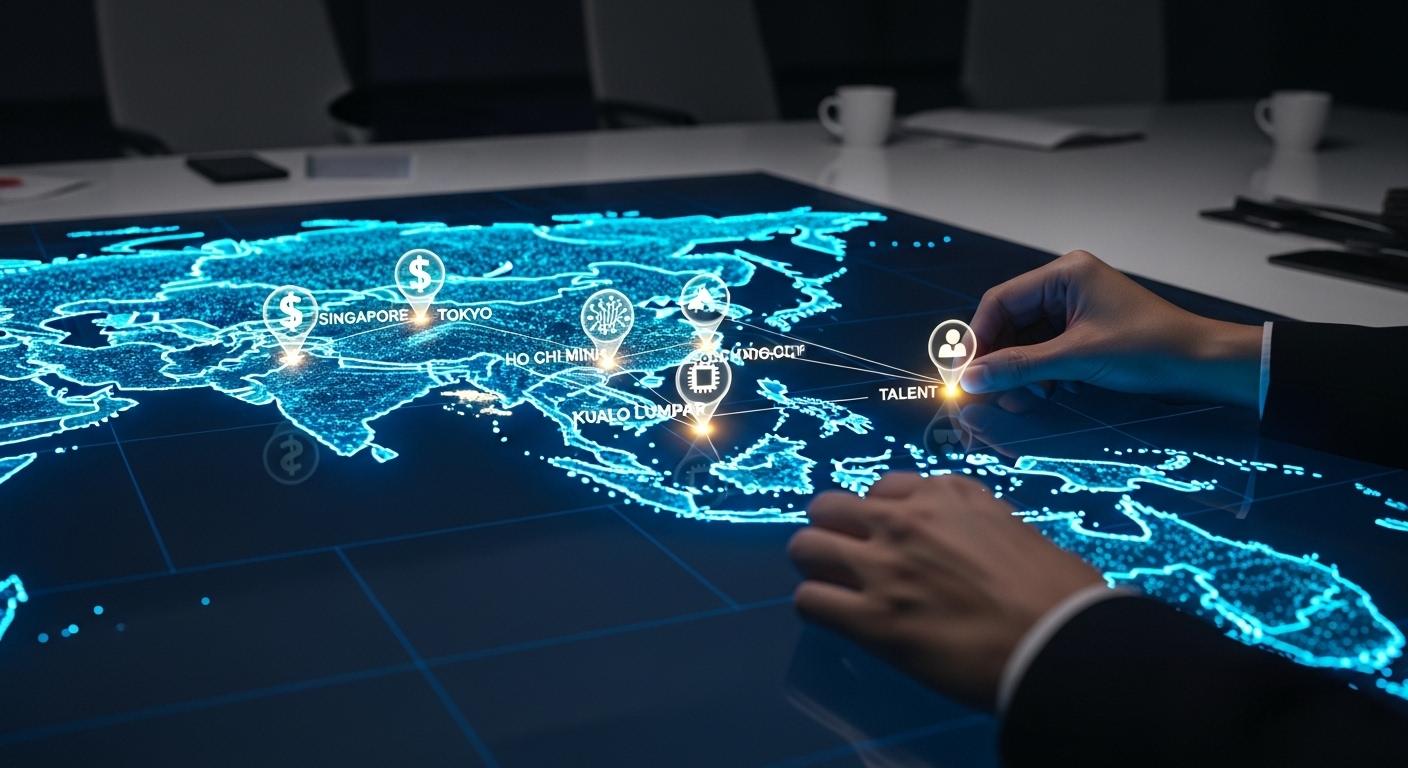In an era of decentralized teams and global markets, the traditional playbook for international expansion is being rewritten. Companies aiming for a significant presence in the dynamic Asia-Pacific (APAC) region often default to establishing a primary hub in Singapore, Hong Kong, or Tokyo. However, a growing cohort of forward-thinking multinational corporations are adopting a counterintuitive yet powerful strategy: anchoring their APAC operations from a European command center. This approach leverages stability, talent, and strategic oversight from a mature market to drive growth in emerging ones. At the forefront of this trend is Paris, a city that blends historical prestige with modern-day innovation. This article explores the compelling reasons why a European anchor, specifically one in the heart of the French capital, is becoming the new power play for orchestrating a successful and resilient Asia-Pacific strategy, bridging continents and time zones to create a truly integrated global enterprise.
The strategic imperative of a European anchor for APAC operations
Managing a burgeoning Asia-Pacific presence directly from a North American headquarters presents significant logistical and cultural hurdles. The vast time zone differences create communication bottlenecks, leading to operational delays and a sense of disconnect between corporate leadership and regional teams. This is where the ‘follow-the-sun’ model, facilitated by a strategic European hub, becomes invaluable. A European anchor acts as a critical intermediary, bridging the gap between the Western and Eastern hemispheres. It allows for a more fluid 24-hour operational cycle, where strategic decisions made in the Americas can be refined and relayed by the European team during their workday, who can then seamlessly hand off to APAC teams as their day begins. Beyond simple logistics, a European base offers a bedrock of political and economic stability. Regulatory frameworks in the EU, such as GDPR, have become global standards, and having a team adept at navigating this complex environment provides a strong compliance foundation that can be adapted for diverse APAC markets. This stability acts as a counterbalance to the volatility that can characterize some emerging economies, allowing companies to plan for the long term with greater confidence. It transforms the expansion strategy from a series of disjointed regional efforts into a cohesive, globally synchronized operation.
Why Paris? The convergence of talent, infrastructure, and prestige
While several European cities could serve as an anchor, Paris offers a unique and compelling trifecta of advantages: unparalleled talent, world-class infrastructure, and undeniable prestige. The city is a global magnet for highly skilled, multilingual professionals, particularly in sectors like luxury goods, finance, technology, and creative industries. This deep talent pool makes it easier to build a central command team with the cross-cultural acumen necessary to manage diverse APAC markets effectively. The concentration of corporate headquarters and financial institutions in districts like Paris 1st provides an unparalleled ecosystem for decision-makers. Infrastructurally, Paris is exceptionally well-connected. Charles de Gaulle Airport (CDG) is one of the world’s busiest international hubs, offering extensive direct flights to every major APAC capital. This connectivity is crucial for executives who need to maintain a physical presence across regions. Furthermore, France’s investment in high-speed rail and cutting-edge digital infrastructure ensures that the Paris hub remains seamlessly linked to the rest of Europe and the world. Finally, the prestige associated with a Parisian address cannot be understated. It enhances a company’s brand image, aiding in attracting elite talent, high-value clients, and strategic partners, signaling a commitment to quality and global leadership.
A tale of two markets: The luxury and finance corridor
Two sectors in particular exemplify the power of the Paris-APAC connection: luxury and finance. For decades, French luxury conglomerates like LVMH and Kering have masterfully orchestrated their vast Asia-Pacific retail and marketing empires from their Parisian headquarters. They have developed a sophisticated understanding of the APAC consumer, managing everything from brand strategy and supply chain logistics to regional marketing campaigns from their central hub. This long-established expertise provides a proven model for success that companies in other sectors can emulate. The skills required to manage a complex network of boutiques in Shanghai, Tokyo, and Seoul are transferable to managing software development teams or client relationships across the same region. In finance, Paris has steadily risen as a key European financial center, particularly in the post-Brexit landscape. It has become a hub for asset management, corporate banking, and FinTech innovation. This financial muscle is critical for companies managing significant capital flows between Europe and Asia, whether for direct investment, M&A activities, or funding regional operations. The city’s robust financial ecosystem provides the tools and expertise needed to navigate complex international transactions and currency markets, making it a secure and strategic base for the financial oversight of APAC growth.
Navigating the digital and regulatory bridge
In today’s global economy, success is as much about managing data and compliance as it is about selling products or services. A Parisian hub serves as a critical bridge for navigating the complex digital and regulatory landscapes that span Europe and Asia-Pacific. The European Union’s General Data Protection Regulation (GDPR) has set a global benchmark for data privacy and security. A team based in Paris is inherently fluent in these stringent requirements, a skill set that is immensely valuable when expanding into APAC countries, many of which are developing their own sophisticated data protection laws inspired by the EU model. This European base allows a company to establish a robust, globally consistent compliance framework, minimizing legal risks and building trust with customers across continents. Furthermore, France’s commitment to digital innovation, exemplified by initiatives like the La French Tech program and the massive Station F startup campus, has fostered a vibrant ecosystem of tech talent and service providers. Companies based in Paris can tap into this expertise to build and manage the secure, high-performance digital infrastructure needed to connect their global operations, from cloud services and cybersecurity to data analytics that can unlock insights into diverse APAC consumer behaviors.
Building the team: Sourcing multilingual, cross-cultural talent
A strategy is only as strong as the people who execute it, and this is where Paris provides a decisive advantage. The city’s international character and high quality of life attract a diverse and highly educated workforce from around the world. It is a place where you can build a central strategy team that is not only technically proficient but also culturally fluent. It’s common to find professionals who speak three or more languages and have direct experience working in or with markets across Asia, Europe, and the Americas. This innate cross-cultural competency is invaluable for a team tasked with overseeing the APAC region. They can interpret market nuances, foster more effective communication with regional offices, and build stronger relationships with local partners and clients. This global talent is particularly drawn to the cultural and professional dynamism found in the city’s core, making a base in Paris 1st a significant advantage in the competitive war for talent. By centralizing the strategic oversight in a location rich with such individuals, a company can ensure that its global vision is translated effectively into locally relevant actions, avoiding the common pitfalls of a one-size-fits-all approach to international expansion.
The operational playbook: Structuring your Paris-APAC hub
Establishing a Paris-based hub for APAC operations requires a clear and deliberate structure. There is no single correct model; the right approach depends on the company’s scale, industry, and strategic goals. For some, the hub may function as a lean, senior leadership team focused purely on high-level strategy, finance, and brand consistency. This team would travel frequently to the region while relying on strong, autonomous country managers to handle day-to-day operations. Another model is the creation of a ‘shared services’ center, which centralizes functions like HR, legal, and advanced marketing analytics for the entire APAC region, creating efficiencies and ensuring consistency. For companies making a major investment, the Paris office could serve as a full-fledged regional headquarters, with divisional heads for APAC based in the city. Operationally, leveraging Paris’s growing ecosystem of flexible and high-end serviced offices can provide a low-risk way to establish an initial footprint before committing to a long-term lease. Regardless of the model chosen, success hinges on establishing rigorous communication protocols. Regular video conferences, a centralized project management platform, and a well-defined travel schedule are essential to ensure the Paris hub and its satellite APAC offices operate as a single, cohesive unit, united by a shared vision and strategy.
In conclusion, the logic of anchoring an Asia-Pacific expansion from Paris is a powerful testament to the new geography of global business. It moves beyond the simplistic notion that proximity is the only path to success, embracing instead a more sophisticated strategy built on stability, talent, and centralized oversight. By leveraging Paris as a command center, companies can effectively bridge time zones, cultures, and regulatory environments, creating a more resilient and integrated global enterprise. The city’s unique combination of world-class infrastructure, a deep pool of cross-cultural talent, and its established expertise in managing global luxury and financial networks provides a potent launchpad for APAC growth. The strategy acknowledges that while on-the-ground execution in Asia is vital, the overarching vision and governance benefit immensely from the stable, prestigious, and connected ecosystem of a premier European capital. For global firms looking to harmonize their growth, establishing a strategic command center in Paris 1st offers a powerful, sophisticated solution to the complexities of managing the Asia-Pacific market, proving that sometimes the longest way around is the shortest way home.





